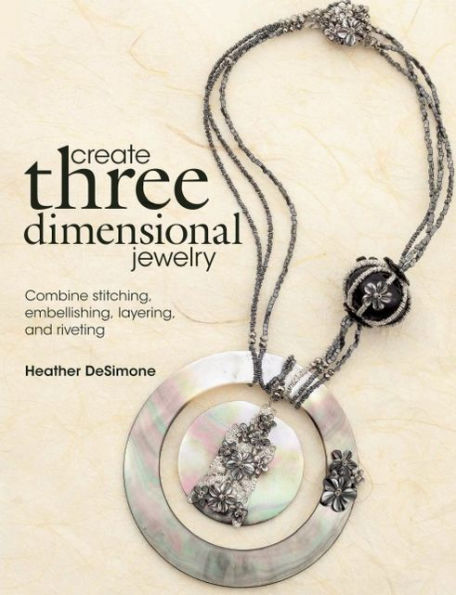5
1

Create Three Dimensional Jewelry: Combine Stitching, Embellishing, Layering, and Riveting
96
by Heather DeSimone
Heather DeSimone

Create Three Dimensional Jewelry: Combine Stitching, Embellishing, Layering, and Riveting
96
by Heather DeSimone
Heather DeSimone
Paperback
$21.99
-
PICK UP IN STORECheck Availability at Nearby Stores
Available within 2 business hours
Related collections and offers
21.99
In Stock
Overview
Inspired by the craftsmanship and attention to detail of early costume jewelry, Heather DeSimone demonstrates how to create fun, one-of-a-kind pieces by teaching techniques for layering readily available components in Create Three Dimensional Jewelry. Jewelry makers will learn how to layer premade components, make beaded clusters, create beaded loops, weave seed beads, embellish filigree components, rivet stamped metal pieces, and more as they create 21 unique projects. Most importantly, mastering this three-dimensional approach to “building” jewelry teaches designers to think about using their materials in a new way.

Product Details
| ISBN-13: | 9780871164940 |
|---|---|
| Publisher: | Kalmbach Publishing Company, Books Division |
| Publication date: | 03/11/2014 |
| Pages: | 96 |
| Product dimensions: | 10.50(w) x 8.10(h) x 0.40(d) |
About the Author
Heather DeSimone is an owner of The Beadin’ Path, a bead shop specializing in vintage and Lucite jewelry in Freeport, ME where she also resides.
Table of Contents
Stacked Pendant Earrings
A simple starter project that represents ‘stacking’ in its simplest form. This design creates a dynamic pair of earrings, with one very easy technique and discussions of how varying the shapes and sizes of the ‘layers’ will change the look.
Button Earrings
A how using stacked center holed components, and then finished to a clip-on, or pierced earring finding. The piece will discuss how to design with layers, alternating materials and suggestions for making decisions on sizes to create your stacks and alternate finishing techniques for the center or ‘stamen’.
The Tudors Necklace
Lucite filigree pieces also make amazing necklace elements. Because of their varying holes, they are a great component to not only stack with, but stitch into. This necklace showcases Swarovski sew-on beads, as well as tiny beads embroidered, or stitched into the bases.
VINYL ENCHANTMENT BY ASHLEY BUNTING
This piece exemplifies how varying materials can be used in layers and stacks.
THE STACKED RING
Layers of metals and shell create the focal point of this riveted ring. This piece is so much simpler than it looks and just takes two spins of the piercing & riveting tool.
WRAPPED IN CHAIN
Ethnic carved wood meets the bling of machine cut crystal. Lashing is used to wire wrap and coat chain links with tiny faceted rondelle beads. Reminiscent of work that Haskell’s designers used to accomplish using tiny glass seed pearls, changing up the materials can create whole a whole other aesthetic.
UNCHAINED
Use traditional stringing or seed bead weaving techniques to create chain and linking elements with various size & shape beads. This piece incorporates both and shows that you can create chain without having a base to stitch around or manufactured chain.
THE NEW DAISY CHAIN
This piece highlights a ‘stacked’ centerpiece that has 2 layers simple glued together: quick overlay technique box featuring a pic using e-6000 to bond to unlike materials - great for finishing off stacks.
CZ beads are used with fine brass wire to make strung chain links.
NOUVEAU CLUSTER CLASP NECKLACE
This piece shows a clasp that has been ornately stitched with various materials. Discuss clasps as focal pieces with as much emphasis as the piece itself. Form and function. Clasp is an example of how you can use specialty findings such as screen-set and filigree clasps, and stitch into them to create clasps that are as much a part of your necklace as beads and other components.
SILVER LINING NECKLACE
A statement piece that uses layered shell donuts and sterling silver. This showcases a stitched mesh clasp, a bead wrapped bead, and a stitched filigree overlay as well as free form stitching on the donuts surface.
THE CUTIES NECKLACE
Weave these darling little ‘cuties’ components and then string them into this mod-tastic, simply strung necklace.
OLIVE DROP HOOPS
Hoop earrings can be decorated and used as a base for freeform wire stitching techniques. These earrings feature an antique rose montee’ sew on bead, found in the French garment district and manufactured in the 1920’s for dress and fabric adornment.
MIRIAM’S PEARL COLLAR
Seed pearls stitched to vintage brass filigree bases were the classic Haskell style. This necklace features vintage pearls from the Haskell stock which were made in Japan ca. 1940’s. Stitched and then simply wire-worked in layers. Drilled glass cabs are worked into the front bib of this necklace.
MOD STITCHED HOOPS
Making your own ‘filigree’ or ‘ajoure’ findings out of vintage lucite earrings you can create an alternative to metal filigree or metal hoops as a base. Vary your drill holes depending on how dense you wish your stitches to be.
THE MEMORY WIRE CUFF
A staple design of the Haskell company: let’s make it current. Use retro lucite beads and multiple pieces of memory wire in segments, we’ll create a base & adorn the centerpiece using filigree & stacked flowers.
FLOWER STACKED MESH BANGLE
Vintage mesh bracelet blanks can be decorated with stacks of flowers & center beads, using the new piercing & riveting tool. The amount of layers one can do, is only limited by the length of your rivet.
STITCHED FILIGREE PIN by ASHLEY BUNTING
Using traditional stitching techniques, learn how to adorn this lightweight Lucite filigree base with varied materials and create a brooch or pin.
From the B&N Reads Blog
Page 1 of
